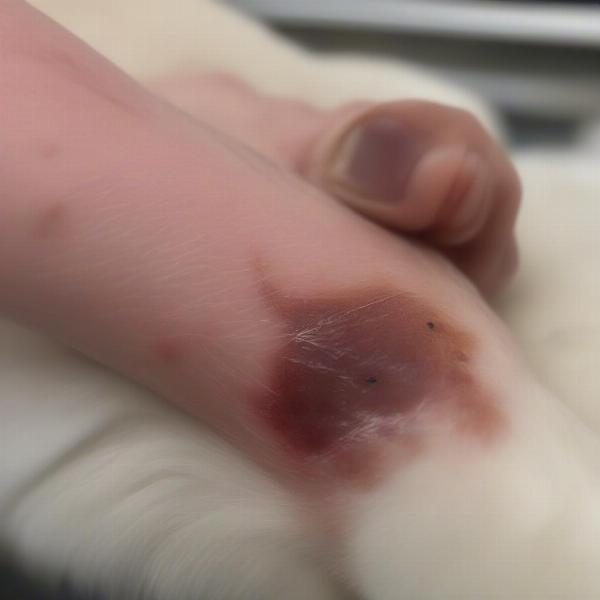Understanding the stages of dog wound healing is crucial for any dog owner. Whether it’s a small scrape or a more serious injury, knowing what to expect and how to provide proper care can significantly impact your dog’s recovery. This guide, along with helpful dog wound healing stages pictures, will walk you through the process and empower you to support your furry friend’s healing journey.
Wound healing in dogs is a complex process that typically involves four overlapping stages: inflammation, debridement, repair, and maturation. Each stage presents unique characteristics and requires specific care considerations. Identifying these stages through dog wound healing stages pictures can help you monitor the healing progress and detect any potential complications.
Understanding the Inflammatory Stage
The inflammatory stage is the body’s initial response to injury. It begins immediately after the wound occurs and lasts for a few days. This stage is characterized by swelling, redness, heat, and pain. You may also notice some discharge, which is a normal part of the body’s attempt to cleanse the wound. During this phase, blood vessels constrict to reduce bleeding, followed by dilation to allow immune cells to reach the injured area.
Don’t be alarmed if your dog licks the wound during this stage, as licking can help remove debris. However, excessive licking can be detrimental, so it’s crucial to monitor your dog closely and use an Elizabethan collar (cone) if necessary.
Debridement: The Cleaning Phase
The debridement stage overlaps with the inflammatory stage and involves the removal of dead tissue and foreign material from the wound. This process is essential for preparing the wound bed for new tissue growth. During this stage, white blood cells called neutrophils and macrophages work to eliminate bacteria and debris.
 Dog Wound Debridement Stage
Dog Wound Debridement Stage
Keep the wound clean by gently washing it with a veterinarian-approved antiseptic solution. Avoid using harsh chemicals or hydrogen peroxide, which can damage healthy tissue and hinder healing.
The Repair Phase: Building New Tissue
The repair phase, also known as the proliferative phase, begins around day 3-5 and can last for several weeks. During this stage, new tissue, including granulation tissue (pink, fleshy tissue) and collagen, starts to fill the wound. New blood vessels form, providing oxygen and nutrients to the healing tissue.
Continue to keep the wound clean and protected. Your veterinarian may recommend using bandages or other wound dressings to promote healing and prevent infection.
Maturation: The Final Stage
The maturation phase, also known as the remodeling phase, is the final stage of wound healing. It can last for months or even years. During this stage, the scar tissue strengthens and contracts, gradually becoming less noticeable. While the wound may appear healed on the surface, the underlying tissue continues to remodel and gain strength.
While looking at dog wound healing stages pictures can be helpful, always consult with your veterinarian if you have any concerns about your dog’s wound. They can assess the wound, provide appropriate treatment, and guide you through the healing process.
Conclusion
Understanding the dog wound healing stages pictures can help you recognize potential problems and seek veterinary care when necessary. Remember to keep the wound clean, protect it from further injury, and monitor your dog closely throughout the healing process. By working closely with your veterinarian and following their recommendations, you can help ensure a smooth and successful recovery for your furry friend.
FAQ
- How long does it take for a dog wound to heal? Healing time varies depending on the wound’s severity, location, and your dog’s overall health. It can take anywhere from a few weeks to several months.
- What should I do if my dog’s wound is infected? Signs of infection include increased redness, swelling, pus, and a foul odor. If you suspect an infection, contact your veterinarian immediately.
- Can I use human antiseptic creams on my dog’s wound? No, some human antiseptic creams can be toxic to dogs. Always use products specifically formulated for pets.
- When should I take my dog to the vet for a wound? If the wound is deep, bleeding profusely, or shows signs of infection, seek veterinary care immediately.
- How can I prevent my dog from licking its wound? Use an Elizabethan collar (cone) to prevent your dog from reaching the wound.
- What is granulation tissue? Granulation tissue is the healthy, pink, fleshy tissue that fills the wound during the repair phase.
- Is it normal for a healing wound to itch? Yes, itching is a common sign of healing. However, excessive scratching can disrupt the wound, so it’s essential to prevent your dog from doing so.
About ILM Dog: ILM Dog is your trusted global resource for expert dog care advice. From breed selection to health and training, nutrition, grooming, and even traveling with your canine companion, we offer practical, reliable information for dog owners of all experience levels. Our team of experts is dedicated to providing you with the latest veterinary insights and best practices to ensure your dog’s well-being. Contact us at [email protected] or +44 20-3965-8624 for personalized guidance.